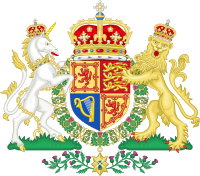
Back High Court of Justiciary German Haute Cour de justice (Écosse) French Alta corte di giustizia (Scozia) Italian Высший уголовный суд Шотландии Russian High Court of Justiciary SIMPLE
| High Court of Justiciary | |
|---|---|
 Royal Coat of Arms of the United Kingdom as used by the Courts in Scotland | |
| Established | 1672 |
| Jurisdiction | Scotland |
| Location | |
| Composition method | Appointed by the Monarch on recommendation of the First Minister of Scotland or Scottish Ministers who receive a recommendation from the Judicial Appointments Board for Scotland |
| Authorised by | |
| Appeals to | Supreme Court of the United Kingdom[note 1] |
| Judge term length | Mandatory retirement at age 75 |
| Number of positions | 36[3] |
| Website | www.scotcourts.gov.uk |
| Lord Justice General | |
| Currently | Lord Carloway |
| Since | 18 December 2015 |
| Lord Justice Clerk | |
| Currently | Lady Dorrian |
| Since | 13 April 2016 |
| Part of a series on |
| Scots law |
|---|
 |
The High Court of Justiciary (Scottish Gaelic: Àrd-chùirt a' Cheartais) is the supreme criminal court in Scotland. The High Court is both a trial court and a court of appeal. As a trial court, the High Court sits on circuit at Parliament House or in the adjacent former Sheriff Court building in the Old Town in Edinburgh, or in dedicated buildings in Glasgow and Aberdeen. The High Court sometimes sits in various smaller towns in Scotland, where it uses the local sheriff court building. As an appeal court, the High Court sits only in Edinburgh. On one occasion the High Court of Justiciary sat outside Scotland, at Zeist in the Netherlands during the Pan Am Flight 103 bombing trial, as the Scottish Court in the Netherlands. At Zeist the High Court sat both as a trial court, and an appeal court for the initial appeal by Abdelbaset al-Megrahi.
The president of the High Court is the Lord Justice General, who holds office ex officio by virtue of being Lord President of the Court of Session, and his depute is the Lord Justice Clerk. The remaining judges are the Lords Commissioners of Justiciary, who hold office ex officio by virtue of being appointed as Senators of the College of Justice and judges of the Court of Session. As a court of first instance trials are usually heard with a jury of 15 and a single Lord Commissioner of Justiciary; the jury can convict on a majority verdict. In some cases, such as the trial of Abdelbaset al-Megrahi and Lamin Khalifah Fhimah for the bombing of Pan Am Flight 103, a trial can be heard by a bench of judges alone; sitting without a jury. As an appeal court the hearings are always without a jury, with two judges sitting to hear an appeal against sentence, and three judges sit to hear an appeal against conviction.
The High Court will hear appeals from the sheriff courts of Scotland where the trial was under solemn proceedings; the High Court will also hear referrals on points of law from the Sheriff Appeal Court, and from summary proceedings in the sheriff courts and justice of the peace courts. Cases can be remitted to the High Court by the sheriff courts after conviction for sentencing, where a sheriff believes that their sentencing powers are inadequate. The High Court can impose a life sentence but the sheriff has a limit of five years sentencing; both can issue an unlimited fine.
As of October 2022, the Lord Justice General was Lord Carloway, and the Lord Justice Clerk was Lady Dorrian, and there were a total of 36 Lords Commissioners of Justiciary.
- ^ Courts Act 1672. Records of the Parliaments of Scotland. 1672. Archived from the original on 14 February 2021. Retrieved 4 April 2017.
- ^ Cite error: The named reference
act_1995_c46was invoked but never defined (see the help page). - ^ Scottish Parliament. The Maximum Number of Judges (Scotland) Order 2022 as made, from legislation.gov.uk.
Cite error: There are <ref group=note> tags on this page, but the references will not show without a {{reflist|group=note}} template (see the help page).